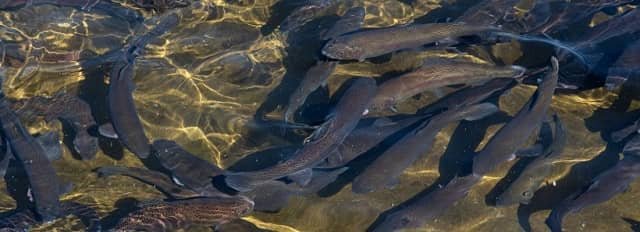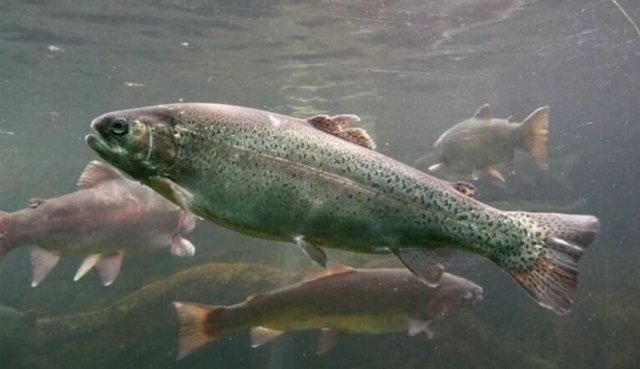
The by-products generated during fish processing are rich in essential nutrients, comprising between 60 and 70% of the whole fish, and serve as a sustainable source for recovering valuable protein compounds.
However, currently, these valuable fish fractions are typically processed to yield low-value products such as fishmeal, animal feed, or used as fertilizers or compost.
In this context, scientists from the Norwegian University of Science and Technology and the Università degli Studi di Milano characterized the physicochemical, antioxidant, and techno-functional properties of protein hydrolysate (FPH) obtained from cultured rainbow trout (Oncorhynchus mykiss).
To ensure product quality, the study involved an extensive characterization of the techno-functional properties of rainbow trout hydrolysate, along with compositional analysis.
Enzymatic Hydrolysis
Enzymatic hydrolysis breaks down protein complexes into small peptides and free amino acids. Bioactive peptides are inactive within the original protein but can be isolated through biochemical hydrolysis like enzymatic hydrolysis.
Various studies have reported that fish protein hydrolysates possess favorable functional properties, such as water solubility, oil-binding capacity, emulsifying, and foaming properties.
“The techno-functional properties of fish protein hydrolysate, such as oil-binding capacity, solubility, freezing and melting temperatures, as well as viscosity, depend on both the type of raw material and process parameters, such as the proteases used, pH, reaction temperature, and hydrolysis duration,” cite the scientists.
They also report that “The functional properties of protein hydrolysates also depend on intrinsic factors, such as the degree of hydrolysis, peptide size, shape, sequence, amino acid composition, and ions present in the mixture.”
Preparation of Trout Protein Hydrolysate
The scientists used eviscerated and decapitated trout, which were chopped and then divided into 1-kilogram batches, frozen, and stored at -80°C until enzymatic hydrolysis.
Stay Always Informed
Join our communities to instantly receive the most important news, reports, and analysis from the aquaculture industry.
FPH was produced by enzymatic hydrolysis carried out at 50°C with the addition of 0.05% w/w of papain and 0.05% w/w of bromelain.
After 60 minutes of hydrolysis, the scientists removed the bones by filtering the hydrolysate through a sieve before inactivating the enzymes by heating to 90°C for 10 minutes. The mixture was then cooled to 30°C before centrifugation.
Nutritional Profile of Trout Protein Hydrolysate
“The total protein content of FPH with a 17.24% degree of hydrolysis was high (88.9%) and mainly represented by water-soluble proteins, while the lipid content was below 1%,” reported the scientists.
Typically, fish protein hydrolysates consist of 2 to 20 amino acids.
According to the study results: “The most abundant amino acids in the trout hydrolysate are Glycine (15.50%), Lysine (11.61%), Glutamic acid (11.15%), Proline/Methionine (10.83%), Tyrosine (8.00%), Aspartic acid (7.63%), Alanine (7.02%), and Leucine (7.67%).”
They also highlight that the trout hydrolysate had low protein oxidation values characterized by a relatively low total carbonyl content along with a significant amount of thiol groups (3.64 ± 0.31 and 20.7 ± 0.6 nmol/mg protein, respectively).
Conclusion
“It has been demonstrated that fish protein hydrolysate (FPH) obtained from rainbow trout raw material exhibits good physicochemical and functional properties compared to well-established food proteins,” conclude the scientists.
They further emphasize that “By hydrolyzing fresh rainbow trout raw material with commercial enzymes papain and bromelain (0.05% w/w each), it was possible to produce FPH with a high protein content, low lipid content, and very low protein oxidation level. FPH contains all essential amino acids and is particularly rich in lysine (11.61%).”
Finally, the scientists point out that “Due to the high physicochemical quality and amphiphilic nature of FPH, which determine its functional properties, rainbow trout hydrolysates are suggested for numerous food applications in the future.”
The study was funded by the ERA-NET programs “FOSC-ERA” and “BlueBio.”
Contact
Janna Cropotova
Department of Biological Sciences Ålesund
Norwegian University of Science and Technology
Ålesund, Norway
Email: janna.cropotova@ntnu.no
Reference (open access)
Kvangarsnes, K., Dauksas, E., Tolstorebrov, I., Rustad, T., Bartolomei, M., Xu, R., … & Cropotova, J. Physicochemical and Functional Properties of Rainbow Trout (Oncorhynchus mykiss) Hydrolysate. Available at SSRN 4332924.
Editor at the digital magazine AquaHoy. He holds a degree in Aquaculture Biology from the National University of Santa (UNS) and a Master’s degree in Science and Innovation Management from the Polytechnic University of Valencia, with postgraduate diplomas in Business Innovation and Innovation Management. He possesses extensive experience in the aquaculture and fisheries sector, having led the Fisheries Innovation Unit of the National Program for Innovation in Fisheries and Aquaculture (PNIPA). He has served as a senior consultant in technology watch, an innovation project formulator and advisor, and a lecturer at UNS. He is a member of the Peruvian College of Biologists and was recognized by the World Aquaculture Society (WAS) in 2016 for his contribution to aquaculture.




